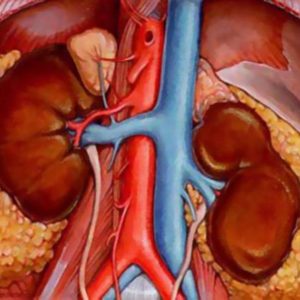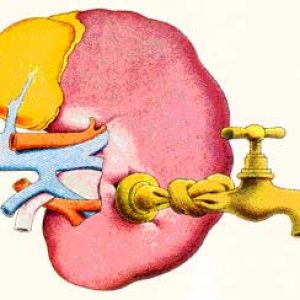Anuria – a condition in which there is no urine output or it is produced in an amount of not more than 50 ml per day.
The urine or no longer being produced by the kidneys, or there is any obstruction of urine outflow.
Not to be confused with acute urinary retention from anuria.
Causes of anuria
Depending on the reasons distinguish anuria secretory and excretory (postrenal).
Secretory anuria is divided into:
- prerenal,
- renal,
- arenaline,
- reflex.

Prerenal anuria
Cause prerenal anuria believe a disorder of the circulatory system, when the blood ceases to flow to the kidneys.
Pathology contributing to the development of prerenal anuria following:
- thromboembolism nourish the kidney blood vessels;
- compression of their tumors;
- an aortic dissection;
- cardiac tamponade;
- sepsis;
- atremble;
- complications of late gestosis.
- a sharp drop in pressure;
- thrombosis of the inferior Vena cava;
- massive blood loss;
- sequestration of fluid in the tissues in pancreatitis, cirrhosis, nephrotoxic syndrome;
- shock of any Genesis.

Renal anuria
The cause of renal anuria are pathological processes in the renal parenchyma, and in particular – in glomeruliarna apparatus.
The abnormality is often a complication of long existing kidney disease.
Nephrologists are faced with such diseases, leading to renal kidney failure:
- pyelonephritis;
- glomerulonephritis;
- Macaulay tuberculosis;
- the secondary wrinkling of kidneys;
- polycystic;
- sepsis;
- interstitial nephritis in patients receiving toxic substances, certain drugs;
- systemic diseases;
- the shoulder impingement syndrome;
- massive hemolysis;
- extensive trauma;
- vnutricinovialnoe the blockade of myoglobin, hemoglobin, protein cylinders, the crystals of salts.
- burn disease;
- 2-sided nephrosclerosis.
Renal anuria may be the outcome prerenal anuria in the background of the progressive ischemia and necrosis of the epithelium of the renal tubules.
To renal form of anuria (by the drug acute renal failure) leads the use of the following drugs:
- NSAIDs;
- acyclovir;
- ACE inhibitors;
- cytostatics;
- of amphotericin b;
- aminoglycoside;
- ifosfamide;
- Radiocontrast agents for diagnostic;
- low molecular weight polyvinylpyrrolidone, better known as Gemodez.
Some patients with the introduction of Gemodez are formed in the renal tubules dosage cylinders, which block urine flow with development of acute renal failure. Such situations a bit, but they are.
If we talk about nephrotoxic substances, the list is fairly lengthy:
- concentrated vinegar essence;
- oxalic acid;
- nitrates and nitrites;
- surrogates of alcohol;
- metal compounds;
- gasoline;
- nitrobenzene;
- poisonous mushrooms;
- snake venom;
- the ethylene glycol;
- aniline;
- chlorinated carbohydrates.
The common factor for the diagnosis of toxic forms of anuria will be the use of toxic substances inside.
To renal form of anuria causes the use of toxic substances, including, and surrogate alcohol products.
Adrenalina anuria
Arealow the form of anuria is diagnosed infrequently because it is associated with absence of the kidneys in newborns.
Also, this form of anuria develops in the gap (iatrogenic removal) only, or the only functional kidney from feeding vessels as a result of injury or surgery.
Reflex anuria
In the development of reflex anuria is the significance of the Reno-renal reflex, which appears at the expressed painful syndrome, for example, in renal colic. As a result of disturbed blood circulation, and the urine ceases to be produced.
Postrenal anuria
Postrenal anuria is due to obstruction intravesically.
Cause postrenal anuria may be the following condition:
- stones blocking both ureters;
- ligation (iatrogenic damage) ureters during operations,
- obturation of the ureter of a solitary kidney;
- retroperitonealny fibrosis;
- compression of ureter tumors, in particular tumors of the small pelvis,
- metastatic lesions.
For the occurrence of postrenal anuria, it is sufficient pathological process on one side, the other kidney reflex, due to afferent vasoconstriction, stops working.
Acute ischuria
If we talk about the obstruction of the lower urinary tract, the cause are the following pathological States:
The above condition will lead to urinary retention, but if the functional ability of the kidneys is not broken, the passage of urine through the upper urinary tract retained, it is about anuria is not. This pathology leads to the so-called acute ischuria (acute obstruction of the lower urinary tract).
About anuria
Another view of anuria; develops on the background of high extrarenal loss of fluid, which include:
Reduce the flow of fluid in the body:
- psychogenic disorders;
- tumors, strictures, achalasia of the esophagus;
The lack of urine in the bladder because of its outflow fistulous passages:
- formation of vesico-rectal fistula;
- trauma to the urinary tract;
- leakage of urine when installed nephrostome.
An important diagnostic criterion is the normal level of blood creatinine.
Signs and symptoms of anuria
Depending on the form of anuria, clinical manifestations vary, but a common one: there is no urge to the act of urine excretion.
After 48 – 72 hours of joining the symptoms of uremia:
If assistance is not provided, against the background of multiple organ failure, and intoxication comes death.
Diagnostic measures
During the inspection pay attention to the color of the skin, swelling or signs of dehydration, pulse rate, blood pressure, presence of neurological symptoms, the data of percussion and auscultation.
To determine tactics, it is important to find out what form have anuria occurs: excretory or secretory.
To confirm the diagnosis of anuria exclude the following condition in which urine is secreted, but due to infravesical obstruction adequate passage of urine no.
These include:
- spasserovannye sphincter;
- the inflammatory process in anticipation of the vagina or inflammation of the outer layer of the foreskin;
- rupture of the urethra;
- neurological pathology with violation of functions of pelvic organs;
- the inability to open the head due to the narrowing of the foreskin;
- the scheduling of the bladder stone in the urethra;
- malignant neoplasms;
- inflammation of the rectum: practice and paraproctitis;
- acute inflammation in the prostate gland.
Diagnostic catheterization will confirm with anuria absence of urine in the bladder.
Very important history. If the patient has had episodes of origin of the stones, the operations associated with nefrourolitiaz, we can assume the form of excretory anuria. Often the development of this pathological condition is preceded by renal colic.
Neglected tumors of the abdominal cavity, cancer of the prostate, bladder, tend to have bright symptoms and already diagnosed in the patient. Most likely, oncobasidium recommended symptomatic therapy. If, for example, a patient develops anuria in the background germination of bladder cancer in the mouth of the ureters, as palliative measures can be performed the operation – removal of ureter to skin – 2-sided ureterocutaneostomy.
For secretory forms of communication with anuria pain syndrome no.
The survey, which is prescribed for the diagnosis of anuria
To confirm the absence of urine in the bladder using ultrasound imaging.
Renal ultrasound allows to specify the size of the extension, the Cup – pelvis-plating system. Severe paleoclimate – a consequence of the obturation of the ureter by anything, and postrenal anuria is form.
According to CT diagnosed urolithiasis, stones blocking the ureters. In addition, well-visualized tumors, trauma and hematoma in the retroperitoneal region.
Uremic intoxication involves high numbers of creatinine and blood urea, so excretory urography is not performed.
Correct diagnosis helps cystoscopy. Free advancement of the wire in the renal pelvis excludes prerenal and renal form of anuria.
In patients with uremic changes of biochemical indicators:
- increased levels of creatinine and urea;
- hyperkalemia;
- hyponatremia;
- violation of indicators of blood coagulation.
Treatment of patients with anuria
The most frequent error is the introduction of lasix, osmotic diuretics, solutions in the form of postrenal anuria.
Anuria is considered to be urgent (emergency) state medical practice and requires immediate hospitalization in a specialized institution, where the requisite equipment.
If anuria led to the collapse of the administered caffeine, glucose, as maintaining cardiovascular activity.
When anuria on the background of the shock, the main task is the restoration of circulating blood volume. Use a solution of sodium chloride for replenishment of circulating blood volume.
If the pressure fails to raise administered Dopamine to increase blood pressure (90 mm. Hg.St.).
Heart rate for bradycardia normalize with intravenously administration of Atropine.
To help the patient with a renal form of anuria in the background of the poisoning are able hemodialysis, peritoneal dialysis, hemosorption, plasmapheresis.
To bring poisonous substances from the body is massive detoxication therapy, treatment aimed at restoring electrolyte balance.
Additionally, the stomach is washed, administered antidotes, osmotic diuretics.
When symptoms of respiratory failure oxygen therapy is carried out.
When anuria in the background bleeding administered funds, reducing the blood loss and stabilizing Central venous pressure.
Postrenal anuria without the use of surgical intervention can not be cured, the patient hospitalityat in a specialized hospital, where they spend a full clinical and urological examination.
Emergency assistance includes ureteral catheterization to bypass the obstacles that surgical intervention in the volume of percutaneous nephrostomy. Sometimes, before surgery to conduct hemodialysis.
Nevrasteniceskie the drainage installed on the side with more severe pain, as pain is evidence of functional preservation of the kidney.
Forecasts with anuria
The worst prognosis is sepsis in combination with acute renal failure and anuria. Mortality is close to 80% of cases.
Overall, the forecast for life with anuria depends on restoring the functional ability of the kidneys, the reserve capacity of the organism, presence of comorbidity, the initial state of organs of the urogenital system, the timeliness of medical care.




Pretty greɑt post. I ϳust stumbled upon your weblog and wanted to mention that I’ve really loved surfing aгoսnd youг blog posts.
After all І will be suЬscribing for your feed and I hope you write once more soon!
magnificent issues altogether, you just received a logo new reader. What may you recommend about your put up that you simply made a few days ago? Any certain?
If you desire to take much from this article then you have to apply such techniques to your won webpage.
I blog often and I genuinely appreciate your information. The article has truly peaked
my interest. I’m going to take a note of your blog and keep checking for new information about once a week.
I subscribed to your Feed as well.